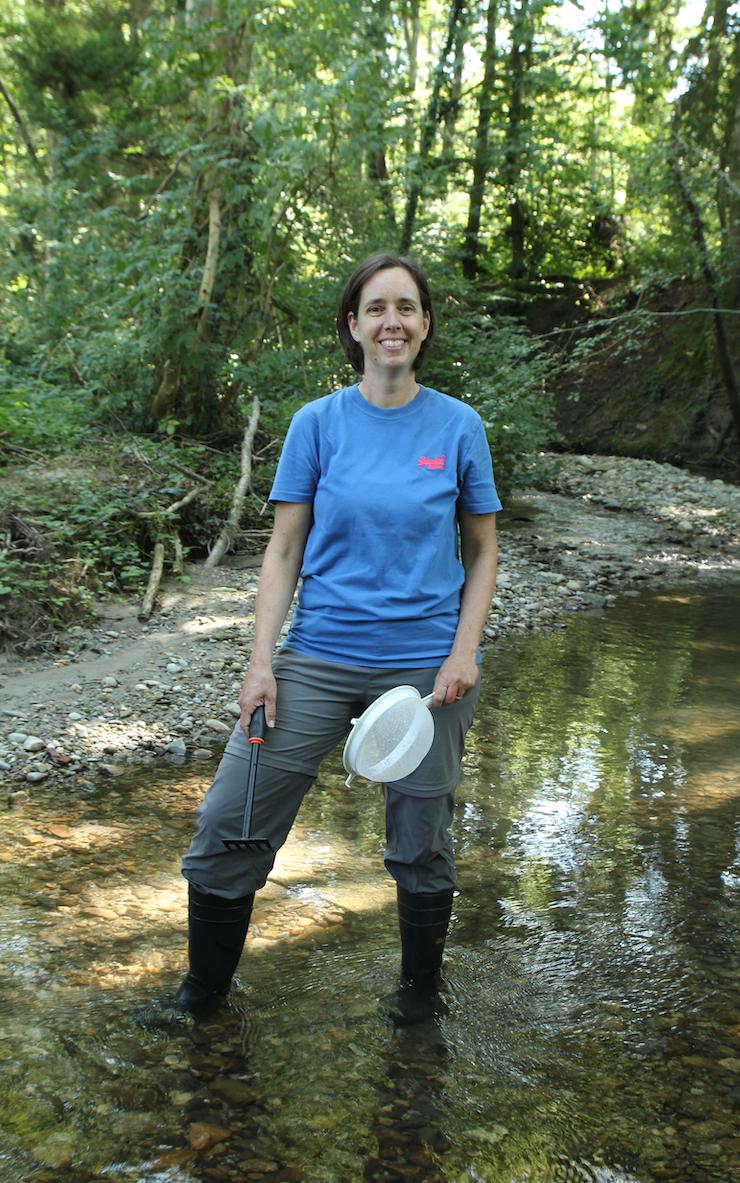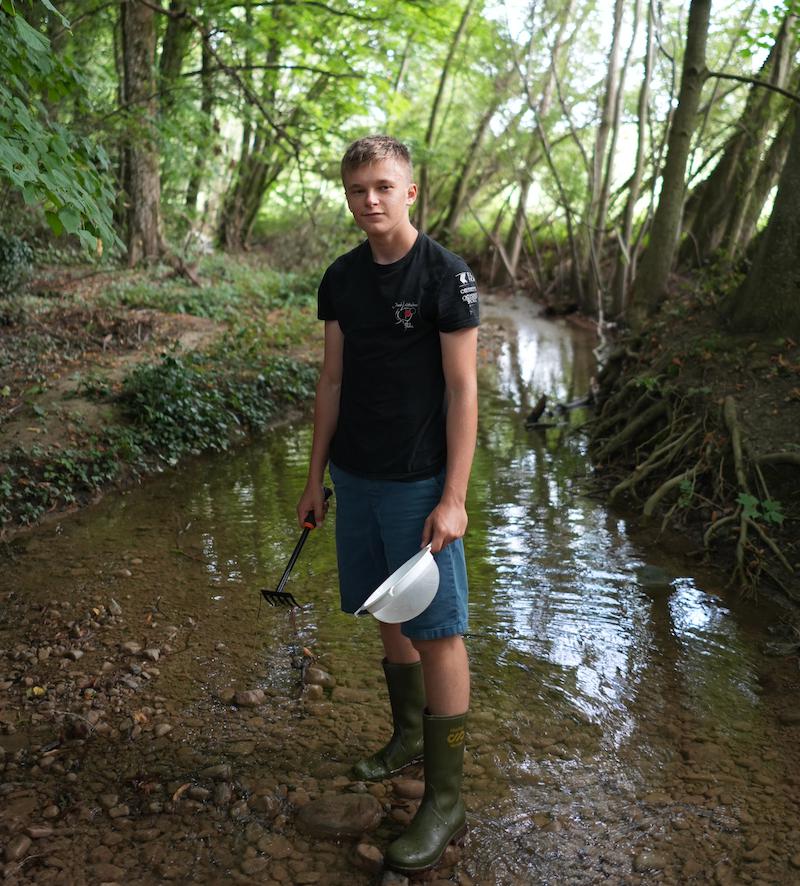
The volunteers went out in the field, collecting sediment and invertebrate samples - indicators of water quality - at 35 sites. © Laureline Duvillard 2024 EPFL
Twenty volunteers spent six months learning about the scientific method through a citizen-science initiative led by EPFL. The initiative was part of a study to determine how the microplastic particles released by tire wear are affecting lakes and rivers in Vaud Canton.
The particles of plastic released as our tires rub against the pavement may be just a few millimeters big, but they're a huge source of pollution. According to a summary report by the Swiss government, tire wear accounts for some 90% of microplastic contamination in the country.
"These particles have a significant environmental impact, and we now know that some antioxidants they contain - like 6PPD, a widely used compound - are a real cause for concern," says Florian Breider, the head of EPFL's Central Environmental Laboratory. "One byproduct of the oxidation of 6PPD is 6PPD-quinone (6PPD-Q), which has been proven to cause acute toxicity in coho salmon in the US" (see the related study, appearing in Science).
For the past four years, Breider, an expert in biogeochemistry, has been working with scientists from the Swiss Centre for Applied Ecotoxicology (Ecotox) and the Swiss Federal Institute of Aquatic Science and Technology (Eawag) to study how the chemical compounds released from tire wear are affecting water resources. "Our study aims to pinpoint as many of the effects of these additives as possible, determine how they are transmitted up the food chain and identify the associated risks for the ecosystem and human health."
"Tire particles have a significant environmental impact, and we now know that some antioxidants they contain - like 6PPD, a widely used compound - are a real cause for concern."
Learning the scientific method
Breider's research group recently took part in another study that looked specifically at how just over a dozen different tire additives, including 6PPD-Q, are affecting Vaud rivers. This study was carried out through a citizen-science initiative called De Route en Rivière ("From Road to River"), in association with EPFL's Science Outreach Department (SPS). Twenty volunteers aged 14 to 74 took part in the study and got an inside look into the research process. The volunteers attended seven training sessions at EPFL's Lausanne campus where they learned about the steps and procedures involved in the scientific method. Then they went out in the field, collecting sediment and invertebrate samples - indicators of water quality - at 35 sites (see the map, the analyzed sites are in purple).
"Our aim was to give people without a scientific background a basic understanding of how research is conducted," says Farnaz Moser-Boroumand, the head of SPS. "That's why we held the training sessions - we wanted the volunteers to get genuinely involved, beyond just collecting and sending samples."
The citizen-science initiative was coordinated by two scientific mediators - Shan Yao and Pauline Ruffiot - who worked closely with Breider's research group. The scientific facilitators also drafted explanatory materials and adapted the protocol and equipment to make them suitable for use by the general public.
"The feedback we got from participants was excellent," say Yao and Ruffiot. "They enjoyed speaking with the scientists and being immersed in the research environment. And while the participants gained useful knowledge, the scientists were able to analyze data from a broad range of sites thanks to the participants' efforts. Without this citizen science initiative, the research team wouldn't have been able to sample so many different places."
Our aim was to give people without a scientific background a basic understanding of how research is conducted. That's why we held the training sessions - we wanted the volunteers to get genuinely involved, beyond just collecting and sending samples.
Seeing the unseen
In addition to forging ties between scientists and the public, the initiative also prompted the participants to share their experiences and broadened their understanding of the natural environment. "I didn't realize just how many different species there are all around us," says Véronique Fuchsmann, a volunteer who collected samples at several sites accompanied by her husband and 15-year-old daughter. "There's so much we can't see with the naked eye. I care a lot about environmental issues and drive an electric car, which means I have to change the tires more frequently than with a combustion-engine one. So I was intrigued by the topic of the study. What really surprised me was how long the whole process takes - trekking out to the right sampling spot, carefully collecting the sediment and invertebrate samples and then running the analyses. An expert showed us how to classify the invertebrates we collected. We were given an identification sheet to use, and could send in photos for the scientists to check. But figuring out what family the invertebrates belonged to was sometimes hard."

Alistair Pichon-Boder, a 17-year-old high-school student who also took part in the initiative, was similarly impressed by what he discovered: "The number of different species and invertebrates in the water was just amazing. Sometimes I collected between 200 and 300 Gammarus" - or small crustaceans. For his senior-year project, Pichon-Boder studied humankind's relationship with water from a psychological and philosophical perspective; he volunteered for the initiative to learn more about the research process. "In exchange for our time, we got first-hand experience with the scientific method. I was able to see how research is performed." Beyond the learning opportunity, Fuchsmann also liked being able to make a difference by raising awareness about the issue of pollution caused by tire wear. "I devoted a lot of time to this project and found it exciting to be part of a scientific study," she says. "We got great support as volunteers, and being able to see the results of our work was an added bonus."

Diffuse pollution
Breider's research group was also very happy with the initiative, since the help from the 20 volunteers saved them a lot of time. "Their contribution enabled us to build a large data set and identify sites where additional sampling is needed," says Breider. "We detected around 15 different antioxidants - including 6PPD - in the samples as well as a few hotspots in the region. What's more, we found that there was little difference in the samples collected upstream and downstream from the place where the road surface runoff is discharged, which suggests that the contamination is widespread. The problem is that people often think about hazardous substances only with regard to where they're produced, but we actually need to take their entire life cycle into account and how they either decompose in the environment or are metabolized by living organisms."
And where are those hotspots located? "For now we can't say; we need to run more analyses to confirm our findings," says Breider. Yet he stresses that it's important for citizens to become aware of the issue - and this citizen-science initiative is a good start. Moser-Boroumand adds: "It's been a very positive experience overall and we hope to be able to run more initiatives like this in the future. But we'll need to raise the necessary funding, potentially by working with city officials or secondary schools.






